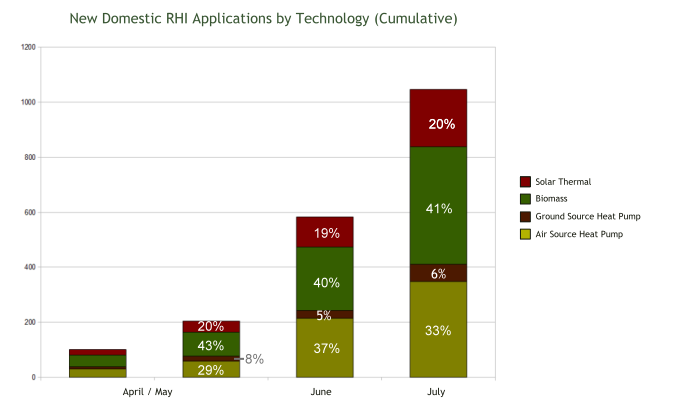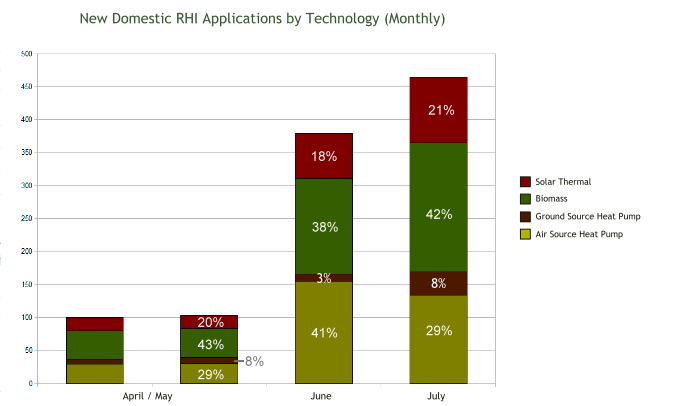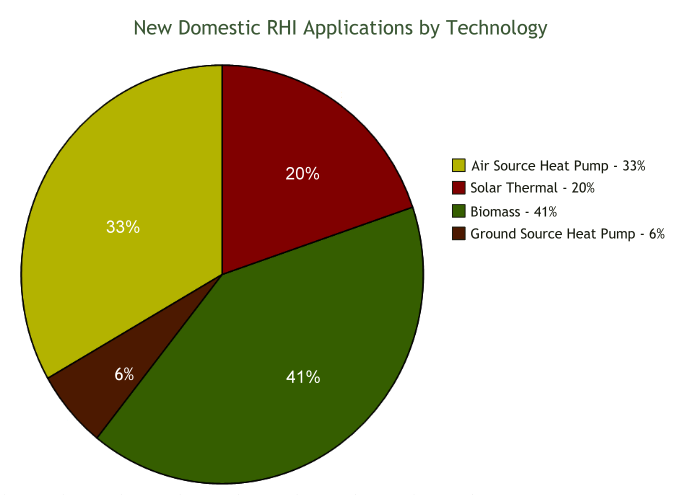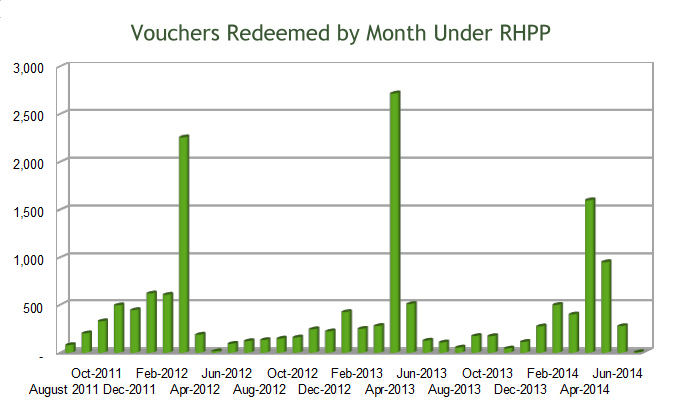
UK Domestic Renewable Heat Update – August 2014
Contents
- Section 1: Introduction
- Section 2: Domestic Heat Growth & Technology Mix Since April 2014
- Total Installation Growth
- Breakdown by Technology
- Air Source Heat Pumps
- Ground Source Heat Pumps
- Biomass
- Solar Thermal
- Section 3: Domestic Heat Under RHPP (August 2011 – March 2014)
- Total Installation Growth
- Breakdown by Technology
Introduction
The domestic RHI launched on the 9th of April, 2014. By the end of May, the first 52 days of the domestic RHI had already seen accreditations pass the 1,000 mark, which is pretty impressive.
Application and accreditation figures to the end of July give us more information and an opportunity to take an early look at activity in the scheme. Stats released by DECC show a total of 4,961 accreditations across all technologies and 7,418 applications.
Before you all rush out to get MCS accredited and take part in this new gold rush, we should point out that the vast majority of the applications and accreditations are legacy applicants. That is, installations that were installed before the launch of the scheme on April 9th, 2014.
The overall application numbers are interesting and show a lot of activity under the scheme. With such a high proportion being legacy applicants however, it is important not to confuse activity under the scheme with current installation activity. The overall numbers give us a picture of renewable heat installations over the last few years. For recent activity, we need to isolate the new installation numbers.
There have been 1,046 applications for systems installed since the launch of the scheme. That’s around 14.1% of applications meaning that 85.9% of applications have been for legacy systems. It is still very early days for the Domestic RHI but new application numbers give us an indication about how popular renewable heat is right now and which technologies are being installed. We will look at new installation numbers in Section 2.
air source heat pumps are still dominating Domestic RHI applications. We need to be careful here though, because the vast bulk of these applications are legacy applications.
About a month ago, Ofgem released an interesting report, “Who are the Domestic Renewable Heat Incentive’s first 1,000 participants?“. In it they examined the first 1,000 installations that were accredited on the scheme. The document makes for an interesting snapshot of what had been accredited and where.
Those first 1,000 accreditations found Air Source Heat Pumps leading the way, in terms of adoption.
The large majority of the first thousand applicants have installed air source heat pumps, followed by solar thermal hot water systems and biomass stoves or boilers.
A month on and there is a lot more data available so we looked again at Domestic RHI applications to see if there is anything we can tell about renewable heat adoption.
| Technology | Applications | Accreditations | ||
|---|---|---|---|---|
| Number | % | Number | % | |
| Air Source Heat Pump | 2,726 | 37% | 1,775 | 36% |
| Ground Source Heat Pump | 1,220 | 16% | 714 | 14% |
| Biomass | 1,604 | 22% | 1,182 | 24% |
| Solar Thermal | 1,868 | 25% | 1,290 | 26% |
| Total | 7,418 | 100% | 4,961 | 100% |
We are more interested in applications since it eliminates the time lag of the accreditation process.
So, with 6,418 more applications in our data, air source heat pumps are still dominating Domestic RHI applications. We need to be careful here though, because the vast bulk of these applications are legacy applications. Legacy applications are made for installations that were installed prior to the launch of the domestic RHI scheme (9th April 2014) but after its announcement in 15th July 2009. So they tell us more about what was installed over the last few years than about what is being installed over the last few months.
The next section will look at data for new applications under the Domestic RHI. This should give us an indication of installations since the 9th of April 2014, whether people have been attracted to installing renewable heat and what technologies are proving popular.
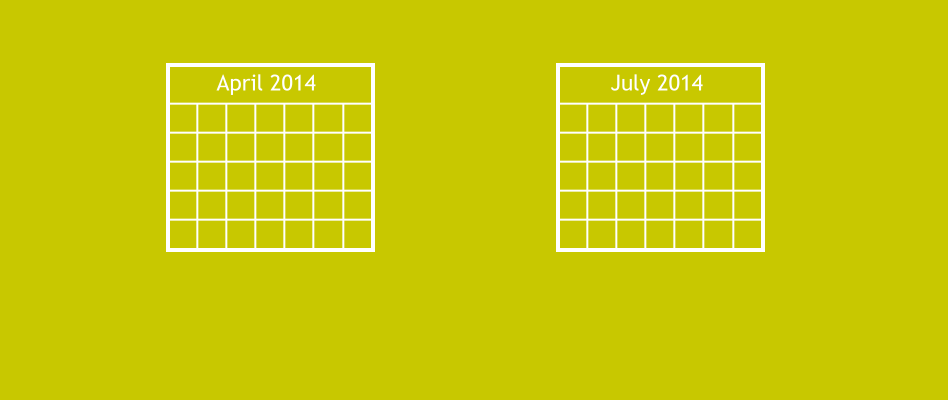
Section 2: Domestic Heat Growth and Technology Mix Since April 2014
The market has been waiting for the Domestic Renewable Heat Incentive for some time now and the clear hope is that the Domestic RHI can stimulate growth in renewable heat. New installation numbers from the Domestic RHI give us our first indication of activity levels under the scheme, although it should be noted that these are very early days.
New applications have so far been increasing month by month.
The first thing to note is that we shouldn’t confuse impressive application numbers from the Domestic RHI with activity levels in the domestic renewable heat market. Of 7,418 applications to date, 85.9% of those (6,372) are legacy applications for installations pre-dating the launch of the scheme. Only 1,046 of the applications represent new installs.
Growth In Renewable Heating Installations
The Domestic Renewable Heat Incentive is in its very early days and we have limited data, covering slightly less than 4 months.
New applications have so far been increasing month by month. From launch on April 9th until May 31st there were only 203 applications for new installations. The month of June saw a further 379 and in July there were 464.
So far activity levels under the Domestic RHI are still lower than the monthly average over the last few years under the RHPP. Over the course of the RHPP there were an average of 427 installs per month across all technologies. This is without doubt an unfair comparison. With the Domestic RHI being so new, it is reasonable to expect that it will take a while to bed in and it is reasonable to expect a further time lag as sales are made and installations are completed. Investing £12,000 or £15,000 in a ground source heat pump system is not an impulse purchase and neither will the installation and its associated works be scheduled and completed in a day.
It is nevertheless good to see applications for new installations increasing under the Domestic RHI. In July, new applications passed the monthly average under RHPP. It will be interesting to see in coming months whether that upward trend continues.
Breakdown by Technology
When we look at new applications, the technology mix is considerably different from the technology mix of legacy applications.
| Technology | Applications | Accreditations | ||
|---|---|---|---|---|
| Number | % | Number | % | |
| Air Source Heat Pump | 348 | 33% | 233 | 32% |
| Ground Source Heat Pump | 63 | 6% | 33 | 5% |
| Biomass | 428 | 41% | 311 | 43% |
| Solar Thermal | 207 | 20% | 144 | 20% |
| Total | 1,046 | 100% | 721 | 100% |
Biomass accounts for the largest share of new applications at 41%. This represents a considerable upswing over previous years. Biomass accounts for only 18% of the applications for legacy installations under the Domestic RHI. Under the RHPP (August 2011 until March 31st 2014), biomass accounted for only 16% of installs. Early indications therefore are that the Domestic RHI is good news for biomass.
Air Source Heat Pumps
There have been 348 applications for new air source heat pumps since the launch of the scheme on July 9th. Air source heat pumps account for 33% of new applications making it the second most popular technology among new applications.
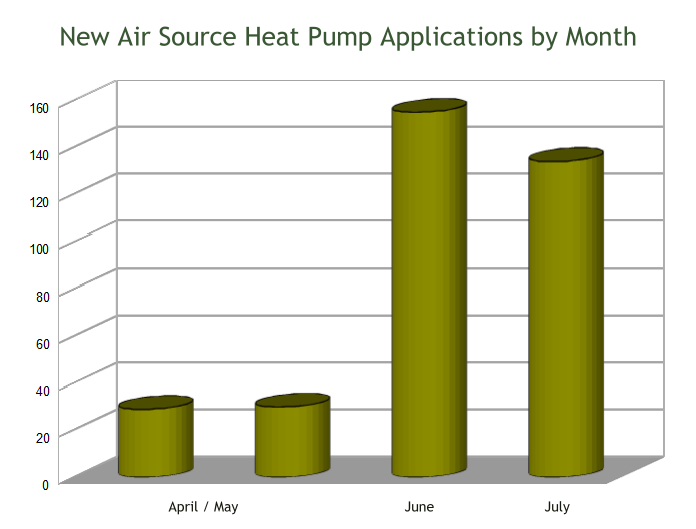
| Month | Applications for New Installations |
|---|---|
| April – May | 59 |
| June | 155 |
| July | 134 |
Ground Source Heat Pumps
Ground source heat pumps account for 63 new applications since the launch of the domestic RHI. This represents 6% of new applications and is significantly below the application levels for the other technologies. July, the most recent month for which we have figures, showed a sharp increase. The early inactivity for ground source heat pump installations may be indicative of the lead time (from consideration, purchase through to completion) for this technology.

| Month | Applications for New Installations |
|---|---|
| April – May | 17 |
| June | 11 |
| July | 35 |
Biomass
So far, biomass has been the most popular technology for new applications under the domestic RHI. There have been 428 applications for new biomass installations since the introduction of the scheme on April 9th. Biomass accounts for 41% of new applications, with air source heat pumps the next most popular at 33%.
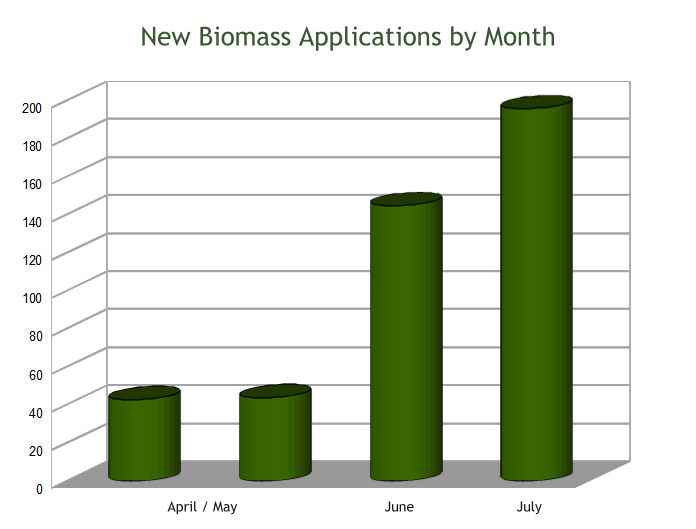
| Month | Applications for New Installations |
|---|---|
| April – May | 87 |
| June | 145 |
| July | 196 |
Solar Thermal
With 207 installations to date, solar thermal accounts for 20% of new applications since the launch of the Domestic RHI. This is lower than the 26% of legacy applications that are for solar thermal and down considerably on the 31% of installations solar thermal accounted for under the RHPP.
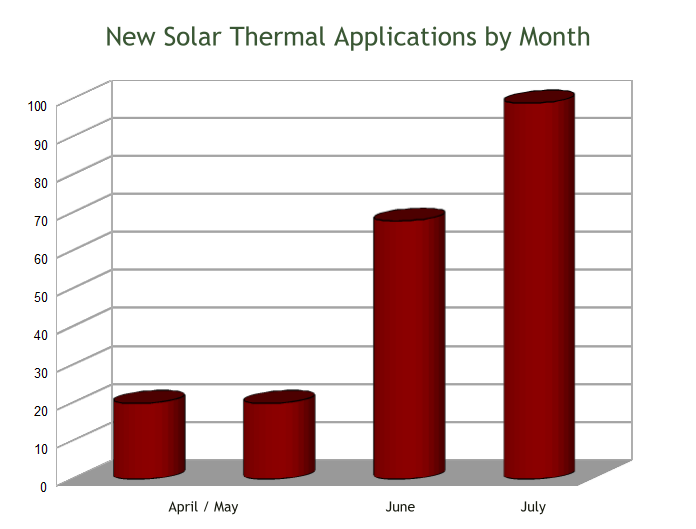
| Month | Applications for New Installations |
|---|---|
| April – May | 40 |
| June | 68 |
| July | 99 |
For comparison, Section 3 looks at installations under the Renewable Heat Premium Payment (RHPP). The RHPP ran from August 2011 to March 2014 in multiple phases and gives us an indication of domestic renewable heat installations during that period.
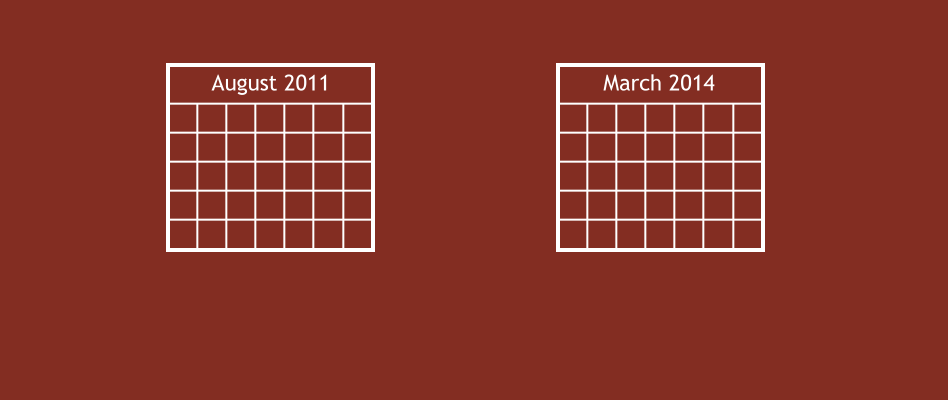
Section 3: Domestic Heat Under RHPP (August 2011 – March 2014)
The Renewable Heat Premium Payment scheme ran from August 2011 until March 31st 2014 and data from the scheme offers some insight into domestic installation numbers for renewable heat technologies over the past few years.
The RHPP was a voucher scheme that provided a one off payment to householders for Heat Pumps (air to water and ground source), Biomass and Solar Thermal. The RHPP ran in three phases as follows:
Air source heat pumps were the most popular technology under the RHPP, accounting for 38% of installations under the householder scheme.
- Phase 1 – August 1st 2011 to March 31st 2012
- Phase 2 – May 1st 2012 to March 31st 2013
- Phase 2 extension – April 2013 to March 31st 2014
The RHPP closed on March 31st 2014 and the Domestic Renewable Heat Incentive was introduced on April 9th 2014.
Total Installation Growth
The RHPP householder scheme saw vouchers redeemed for 15,364 renewable heat installations from August 2011 until July 2014. The graph below shows the vouchers redeemed in each month of the scheme. Based on the vouchers redeemed, there have been an average of 427 installations per month over the period since August 2011. It is clear from the graph below however, that this activity has been heavily concentrated around the closing months for each phase of the scheme.
It is worth noting that homes which were replacing a mains gas heating system were eligible for support under the RHPP only for solar thermal. RHPP funding was not available for heat pumps or biomass where the home had recently been heated by mains gas. This made the RHPP largely relevant only for off gas grid homes. While the Domestic RHI is targeted at off gas grid homes, it is available to both. In fact, Ofgem’s figures for the first 1,000 Domestic RHI accreditations showed that 30.6% were switching from gas. This was second only to oil, which 43% had switched from.
Breakdown by Technology
Air source heat pumps were the most popular technology under the RHPP, accounting for 38% of installations under the householder scheme. Solar thermal installations also performed strongly at 31%.
When comparing installations during the two and a half years of the RHPP with the first few months of the Domestic RHI, it looks like air source heat pumps have maintained their popularity. Air source heat pumps saw the strongest installation numbers under the RHPP and this popularity over the last few years is reflected in the legacy application numbers under the Domestic RHI. While not the most popular technology among new Domestic RHI applications, air source heat pumps have still performed strongly at 33%.
The popularity of solar thermal under the RHPP may be a function of the design of the scheme. Solar Thermal was the only RHPP technology available to homes that were on the gas grid and this may partially account for the popularity of solar thermal being so much higher over the period of the RHPP than it seems to be so far under the Domestic RHI. Other differences in the schemes may also have an impact on the relative popularities of the technologies. Solar Thermal is less expensive to install than heat pumps or biomass and it may be that homeowners considering installing the more expensive technologies have been less likely to risk proceeding with projects until the Domestic RHI was actually in place. This would put a downward pressure on the installation numbers for technologies like biomass or ground source heat pumps under the RHPP and any pent up demand would show in the installation numbers under the Domestic RHI. It is too early to judge at this stage.



